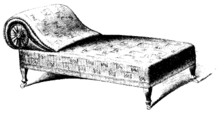Chaise longue


A chaise longue (English /ˌʃeɪz ˈlɔːŋ/;[1] French pronunciation: [ʃɛz lɔ̃ɡ], "long chair") is an upholstered sofa in the shape of a chair that is long enough to support the legs.
The architect Le Corbusier designed a Chaise Longue, which he called the LC-4 Grand Confort, that has become a classic item.
In modern French the term chaise longue can refer to any long reclining chair such as a deckchair. A literal translation in English is "long chair". In the United States the term lounge chair is also used to refer to any long reclining chair. Chaise longue is sometimes incorrectly written and pronounced as "chaise lounge".
Origins
It is thought that the first blend of a chair and daybed originated in Egypt. The earliest known models were made from palm sticks lashed together with pieces of cord or rawhide. Later, Egyptian bed-makers introduced mortise-and-tenon construction and wood bed frames veneered with ivory or ebony, in common use with many examples being found in the 1st dynasty (3100–2890 BC) tombs.[2]

Ancient Greek art depicts gods and goddesses lounging in this type of chair. The modern Greek word symposion comes from sympinein, which means "to drink together". In ancient Greece this word conveyed the idea of a party with music and conversation. The principal item of furniture for a symposium is the kline, a form of daybed. The Greeks changed from the normal practice of sitting at a table to the far more distinctive practice of reclining on couches as early as the 8th century BC.[2]
The Romans also used a daybed for reclining in the daytime and to sleep on at night. Developed from the Greek prototype, the Roman daybed was designed with legs carved in wood or cast bronze. The Romans also adapted a chaise longue style chair for the accubatio (the act of reclining during a meal). At Roman banquets, the usual number of persons occupying each bed was three, with three daybeds forming three sides of a small square, so that the triclinium (the dining-room of a Roman residence) allowed for a party of nine.[2] The Romans did not practice upholstery, so the couches were made comfortable with pillows, loose covers and animal skins.[3]
Types

- A contemporary chaise longue by Italian designer Vico Magistretti (1996).

- Duchesse brisée (Broken duchess in French): this word is used when the chaise longue is divided in two parts: the chair and a long footstool, or two chairs with a stool in between them.[4] The origin of the name is unknown.

- Récamier: a récamier has two raised ends, and nothing on the long sides. It is sometimes associated with French Empire (neo-classical) style. It’s named after French society hostess Madame Récamier (1777–1849), who posed elegantly on a couch of this kind for a portrait, painted in 1800. The shape of the récamier is similar to a traditional lit bateau (boat bed) but made for the drawing room, not the bedroom.[4]

- Méridienne: a méridienne has a high head-rest, and a lower foot-rest, joined by a sloping piece. Whether or not they have anything at the foot end, méridiennes are asymmetrical day-beds. They were popular in the grand houses of France in the early 19th century. Its name is from its typical use: rest in the middle of the day, when the sun is near the meridian.[4][5]
See also
References
- ↑ Dictionary Reference: chaise longue
- ↑ 2.0 2.1 2.2 The History of the Chaise Longue
- ↑ Past and Present: The Chaise Longue
- ↑ 4.0 4.1 4.2 Is a recamier the same as a chaise longue? retrieved Feb 9, 2009
- ↑ Meridienne entry at dictionary.com
External links
| Wikimedia Commons has media related to Chaise longue. |
- http://antiques.about.com/od/antiquechairstyles/a/ChaiseLongue072810.htm
- http://www.fusionliving.co.uk/seating-c3/chaise-longues-c15 Contemporary Chaise Longue